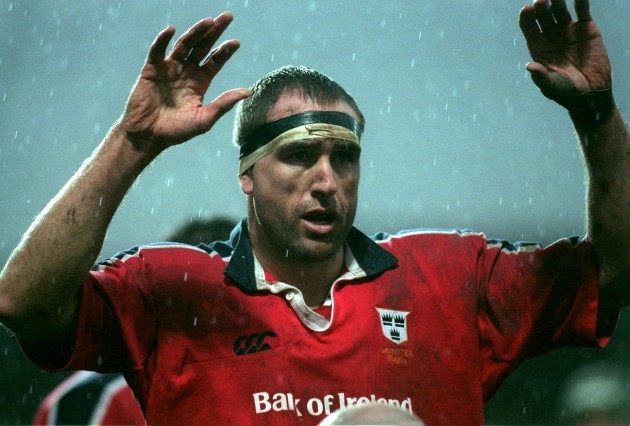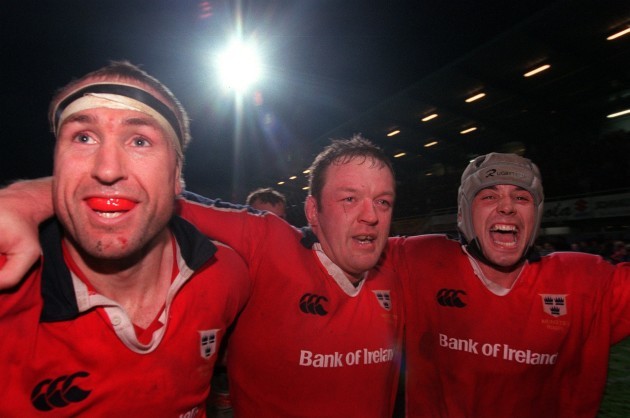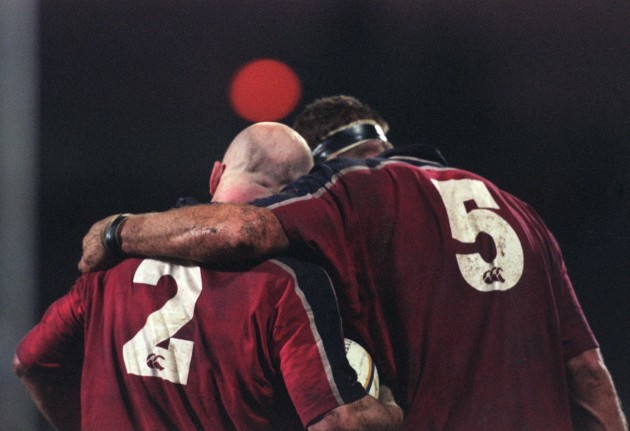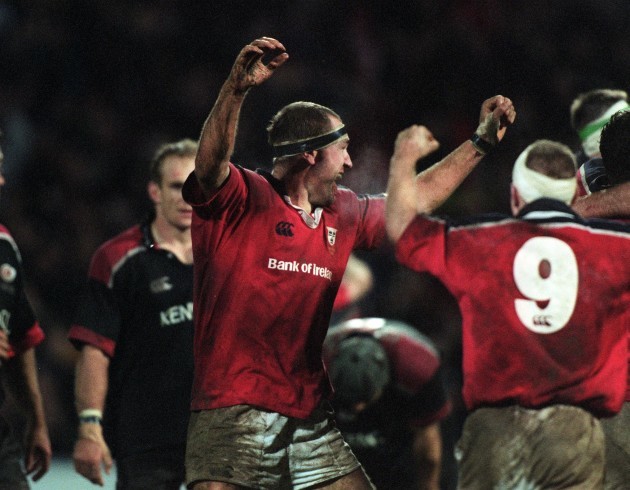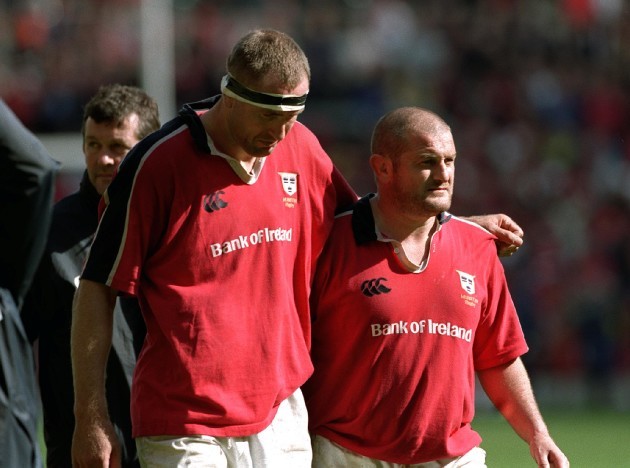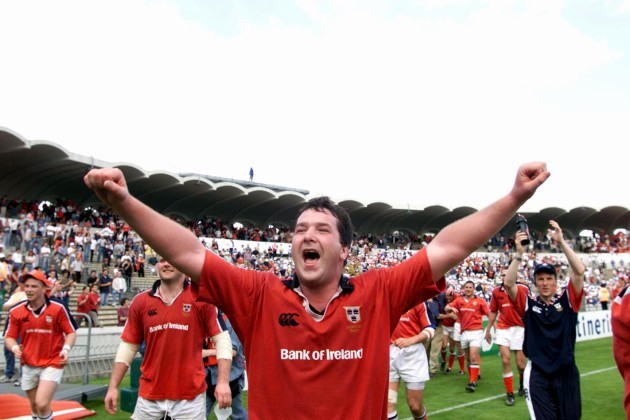THERE WERE MANY times in his first few weeks with Munster when John Langford wondered what he had gotten himself in for.
There was the fishing trip with Dominic Crotty, Brian O’Brien and David Corkery where, after a collective bout of seasickness, they caught plenty of mackerel and Langford was explaining how smoking their catch would be the best option when they were back on dry land.
The captain of the boat they had rented disagreed, insisted raw was best and bit the head off one of the mackerel moments after it had been reeled in.
There was the unforgettably rough first landing into Shannon airport, the plane bouncing back up off the runway before thumping down permanently, at which the pilot announced, “Welcome to Shannon, two landings for the price of one.”
There was the time Munster were in Kilkee for a training camp and when they went on an orienteering trip, Langford pointed out that he was carrying an ankle injury and might have to sit it out.
Declan Kidney’s response: ‘That’s alright, if you come back we know the ankle is alright, if you don’t come back we know you won’t be right to play.’ Langford completed the course with flying colours.
And then there was Peter Clohessy, known to one and all simply as ‘Claw.’
Sitting in Brisbane before Ireland’s first Test against the Wallabies, Langford smiles and laughs often as he recalls his three years with Munster from 1999 onwards – during which time he had a major influence on the province’s progress.
With him on the trip to Brisbane from their home in Sydney is his 18-year-old son, Connor, who was born in Limerick.
Langford and his wife, Nicole – who also have two daughters, 15-year-old Olivia and 10-year-old Anna – remain in close contact with the lifelong friends they made in Munster but in those early days, the Australian second row had a few reality checks after coming from the extremely professional Brumbies set-up.
“We were in Wales for a warm-up match and we hopped on the bus and we’re heading down the road,” recalls Langford.
“A few guys are playing cards and I suddenly think, ‘I can smell cigarette smoke.’ I was just thinking, ‘How rude of the bus driver, we’re going to play a match and he’s smoking.’
“But then I look down the back of the bus and there’s Claw, fag in his mouth, puffing away on the way to the game! I’m thinking, ‘What have I got myself into!’”
Isa Nacewa’s recent retirement restarted the debate about the greatest ever import into Irish rugby and many would put Langford’s name forward for that title.
While the Australian lock was gone by the time Munster finally reached their holy grail of Heineken Cup success in 2006, his influence on the province’s professionalism and training approach has been stressed by virtually everyone who was part of the journey to that long-awaited European trophy.
The funny thing is that Langford very nearly ended up being a Leinster player.
He had lost his starting spot at the Brumbies to Justin Harrison when he decided to cash in and look for a club in the UK or France, but the lack of a European passport made things more difficult.
A coach of his at the Brumbies, Jake Howard, suggested looking in Ireland and Langford made contact with former Leinster Branch and IRFU president Peter Boyle.
“I started to talk to Boyler and was looking, believe it or not, to play for Leinster,” says Langford.
“We had agree on an amount, nothing like what they get paid now – I nearly fell over when I heard what some of the second rowers get now! – but I had agreed terms and when people asked me where I was going, I said ‘I’m going to Leinster.’”
But all of a sudden, the communication from Leinster stopped and two weeks passed before Langford got in touch with Boyle, who informed him that the IRFU had decided only Irish players who were contracted in the country could go to the 1999 World Cup.
Malcolm O’Kelly returned to Leinster from London Irish and the second row spot that was meant to be Langford’s was gone.
Boyle recommended giving Munster a call and when Langford came to London to play for the Barbarians, he met the province’s manager, Brian O’Brien, and assistant coach, Niall O’Donovan – who is still involved today as team manager.
“I’ll never forget when I put my hand out to meet Briano and he’s just grabbed me on tummy and had a squeeze and gone ‘That’s alright,’” says 49-year-old Langford.
Langford had a good game for the Barbarians and flew on to meet Munster boss Declan Kidney in Limerick, where he had his first experience of the now-London Irish director of rugby’s ability to chat incessantly around rugby.
“It was supposed to be half an hour but it went for an hour and a half, with Deccie doing all the talking.
“I actually remember back then that it was quite expensive to make calls on mobile phones in Ireland and there was a way of doing it where you could add another digit to the number and it would ring straight through to the voicemail, bypass the phone.
“Because Deccie would talk for an hour and you had to pay for the call, ROG used to ring straight through to the voicemail and say ‘Declan, I tried to call you.’”
Langford was 30 when he signed for Munster but the fact that he had taken up rugby relatively late probably contributed to him still being in incredibly good condition.
A native of Wagga Wagga, situated between Sydney and Melbourne, Langford didn’t know much about rugby union as he grew up in a city where Aussie Rules and rugby league were dominant.
He was a cross-country runner in his later school years and it wasn’t until he was studying engineering at Sydney University that he was finally convinced to give rugby a go, being drafted into their fifth-grade team when they were short on numbers.
“I remember the boys trying to explain the rules to me on the way to the game, but they forgot to tell me you couldn’t trip and this guy got away on me, so I threw up my leg and tripped him.
“All these guys from the opposition are trying to punch me all of a sudden!”
Even without any idea of what was going on, Langford loved the physicality and competitiveness, going on to play for the university’s U21 side and rapidly developing into an excellent, athletic second row.
He played for New South Wales before a switch to NSW Country allowed him to feature in games against nations like South Africa and Wales on their tours of Australia, while he captained Australian Universities in 1993 and played for the Emerging Wallabies on a tour of South Africa in 1994.
Rugby was still amateur at that stage, of course, and Langford had gone into a job as an engineer in railway construction after college, a job he is still doing now.
“I consider myself very fortunate to have seen the amateur side of the game and to grow up in a world without mobile phones because you would probably have been in a lot of trouble with mobile phones with the messing we used to get up to!” says Langford.
“We weren’t making money out of it, so the things we used to get up to slipped under the radar.”
But professionalism was on the way and Langford’s impressive form for the Gordon club convinced Brumbies coach Rod Macqueen to give him a call ahead of the inaugural Super Rugby season in 2006.
With the starting salary matching his earnings in engineering, Langford jumped at the chance of becoming a foundation member of the Brumbies and was part of an excellent team that went on to reach the 1997 Super Rugby final, alongside the likes of Joe Roff, George Gregan, Stephen Larkham, Ewen McKenzie and Owen Finegan.
Langford earned Wallabies selection in 1996 and 1997, winning four caps against New Zealand, South Africa, England and Scotland but by 1999, with Eddie Jones by then in charge of the Brumbies, the second row was looking for a new adventure outside Australia. Munster proved to be his new home.
“I felt I still had some good years in me,” says Langford. “I felt there was a bit of an expectation in Australia that you get to 30 and you’re too old, but I felt I had something to prove.”
Though his new team-mate Anthony Foley gave Langford a bit of a scare at the very beginning, his level of fitness made a big impression at Munster.
The Australian has been consistently credited with bringing about far greater training standards and improved strength and conditioning in Munster, which played a vital role in their eventual rise to European success.
“I remember one of the first sessions down at UL and I lined up beside Axel for a sprint test and I was thinking, ‘This fat bastard, I’ll beat him easy,’” says Langford.
“Fergal O’Callaghan, our strength and conditioning coach, blew the whistle and Axel was about two yards in front of me before I’d even twitched. He was deceptively quick off the mark.
“But we did the 3k run and I lapped John Hayes on about the second lap! I was one of the fittest guys back home and that was probably the difference with me, I could go all game.
“I think the guys in Munster thought everyone in Australia was like that so it might have been a wake-up call for them that way.
“I’d heard stories about when it first turned professional and they said, ‘Right, train for eight hours a day’ and they’d flog the boys. Eight hours a day training and you’d try to play at the weekend but they’d be wrecked and they were losing.”
Munster’s expectations needed to be lifted too.
“We had this session in one of the theatres down in UL and the legend Dave Mahedy [now UL's director of sport and recreation] was there with us, so we’re sitting there as a squad and the question comes up, ‘Who thinks we can win the Heineken Cup this year?’
“I put my hand up, Woody [Keith Wood] put his hand up and one other person. They’re asking can we go through the season undefeated and the three same blokes put their hand up. I was thinking ‘Why not? What games are we planning to lose?’
“The same question was asked the next year and every hand in the room went up! I wish I had a video of that.”
Off the pitch, Nicole also had an influence.
“She would come to all the functions because that’s what we did at the Brumbies,” explains Langford.
“I think she made a change to a few things in Munster in terms of getting the wives and girlfriends to come to post-match functions and things like that. You look back and think ‘How was it not always like that?’ It was important.”
While Munster’s approach to training changed, with Langford’s experiences with the Brumbies proving important, he also learned plenty from playing with his club side, Shannon, in the AIL and in the red jersey of Munster.
“Even from the first match for Shannon, I could see these guys were working themselves up into a frenzy to play. I went up to Geoff Moylan, the coach, and said ‘This seems a bit wrong, why aren’t we focusing?’
“We used to do that in the Brumbies, focusing on each bit of play, like the kickoff, focusing on all that. After a couple of weeks playing for Shannon, I gave up.
“The passion of the players was something I’d never experienced before and I sort of ended up mirroring it. It was very powerful running onto the pitch with that passion, whereas in the Brumbies it wasn’t this same raw passion, it was more technical. When you blend the passion with the right skills, that’s when you get the results.”
Munster certainly began to click and Kidney’s side won five of their six pool games in the Heineken Cup – including a stunning win away to Saracens – before beating Stade Français in the quarter-finals and pulling off their famous 31-25 win away to Toulouse in the semi-finals.
Suddenly, Kidney’s men found themselves in the 2000 Heineken Cup final and the agony of that 9-8 defeat to Northampton lives on to this day.
Langford, having laughed through our interview, sighs and ruefully shakes his head when it comes up.
“My mate here in Brisbane, Tony Rees, won a Heineken Cup with Brive in 1997 and he was saying they had a 20-year reunion for that team. We were just a couple of points shy of that. It was heart-breaking, there were tears from everyone.
“A lot of our games were won with the kicks ROG got. I’ll never forget at Twickenham the day before at our captain’s walkthrough, Ronan was kicking and it was very blustery. He wasn’t listening probably but I remembering saying to him to watch the wind.
“We got a penalty kick towards the end of the game and I was behind Ronan, it was almost exactly where I’d seen him kicking the day before and it was the same blustery wind. I was right behind and the kick started well but just faded to the left. It was heartbreaking.
“I don’t blame him for that at all because we wouldn’t have got to where we got without ROG; he won us so many games with his kicking.
“I ran into Paul Grayson [who kicked Northampton's nine points that day in Twickenham] at a Legends match in 2013. I saw him at the after-match function and I could have throttled him for his kicks that day!”
Though he only signed on for one year at a time, Kidney managed to convince Langford and Nicole to stay on for three seasons before they returned home to Australia.
By the time Langford was getting set to move on, the next great Munster second row, Paul O’Connell, was emerging.
“Paulie came onto the scene at that time and I remember playing against him at the Cookies, he made a big impression,” says Langford.
For his part, O’Connell was impressed by the Australian.
“Langford was a superstar of a second row,” says O’Connell in his book, The Battle. “If it wasn’t for John Eales, he’d probably have won fifty caps for the Wallabies.”
Though Munster couldn’t get over the line in his time there, Langford is grateful to have played with legends like Clohessy, Alan Quinlan, David Wallace, Hayes, O’Gara, Peter Stringer, ‘Dutchy’ Holland, Mike Mullins, Crotty, Anthony Horgan and John Kelly.
Langford formed a great connection with hooker Wood, which proved important in that march to the 2000 final.
“Woody was back that year, what a player,” says Langford. “You talk about people being 100% all the time, he was 300% into everything, so to have Woody there was great.
“It was something that just clicked between us in training. We worked very well together and it was a great combo. Frankie Sheahan stepped in after and continued that.
“I had a go at Woody the other day because Munster played Ireland twice in my time, even before the World Cup in 1999 we beat them down in Musgrave Park. All the fellas who didn’t get picked were angry. Woody was telling the story of how Axel nearly cut him in half!”
Mick Galwey was the captain of the team and Langford’s second row partner.
“He was great, the respect he got,” says the Australian. “We had a dinner down in Charleville once. I was asked to speak and I told a few home truths about Gaillimh and it wasn’t complimentary, but I was just joking obviously.
“Well, I thought they were going to bloody lynch me, they didn’t like me talking poorly of him! He was up there on a pedestal and I didn’t think I’d get out of there alive. He was a great captain and he would give everything and get stuck in.”
And then there was the great Axel, a dear friend of Langford’s, their bond built up during times they shared on the pitch, the laughs they had off it, the chats during their car trips from Limerick to Cork and back for training, with Marcus Horan and Colm McMahon part of their crew too.
Langford’s most recent visit to Ireland was a desperately sad one as he attended Foley’s funeral in Killaloe in 2016.
Langford explains that his son Connor’s Irish godparents are Axel and Olive Foley, a sign of the connection between the two families.
“Axel used to advise me which journalist I could talk to and who not to talk to,” says Langford with a smile as our chat draws to a conclusion.
“Axel had a rugby head on his shoulders. He could just see things I couldn’t and he could play. I remember him winning the pizzas for life in Domino’s for this three tries and there was no better man for it, even though he said he didn’t eat that many.
“We miss him dearly.”
- This article was updated at 9.32pm to correct ‘Boylan’ to ‘Moylan’.
The42 is on Instagram! Tap the button below on your phone to follow us!
